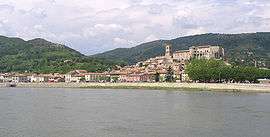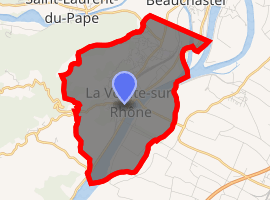La Voulte-sur-Rhône
La Voulte-sur-Rhône is a commune in the Ardèche department in southern France.
La Voulte-sur-Rhône | |
|---|---|
 La Voulte-sur-Rhône seen from across the river | |
.svg.png) Coat of arms | |
Location of La Voulte-sur-Rhône 
| |
 La Voulte-sur-Rhône  La Voulte-sur-Rhône | |
| Coordinates: 44°48′01″N 4°46′48″E | |
| Country | France |
| Region | Auvergne-Rhône-Alpes |
| Department | Ardèche |
| Arrondissement | Privas |
| Canton | Rhône-Eyrieux |
| Intercommunality | Confluences Drôme Ardèche |
| Government | |
| • Mayor (2008–2014) | Marc Bolomey |
| Area 1 | 9.70 km2 (3.75 sq mi) |
| Population (2017-01-01)[1] | 4,987 |
| • Density | 510/km2 (1,300/sq mi) |
| Time zone | UTC+01:00 (CET) |
| • Summer (DST) | UTC+02:00 (CEST) |
| INSEE/Postal code | 07349 /07800 |
| Elevation | 85–405 m (279–1,329 ft) (avg. 98 m or 322 ft) |
| 1 French Land Register data, which excludes lakes, ponds, glaciers > 1 km2 (0.386 sq mi or 247 acres) and river estuaries. | |
Population
| Historical population | ||
|---|---|---|
| Year | Pop. | ±% |
| 1793 | 1,168 | — |
| 1800 | 1,369 | +17.2% |
| 1806 | 1,261 | −7.9% |
| 1821 | 1,419 | +12.5% |
| 1831 | 1,920 | +35.3% |
| 1836 | 2,189 | +14.0% |
| 1841 | 2,459 | +12.3% |
| 1846 | 3,155 | +28.3% |
| 1851 | 3,153 | −0.1% |
| 1856 | 3,045 | −3.4% |
| 1861 | 3,285 | +7.9% |
| 1866 | 3,160 | −3.8% |
| 1872 | 3,534 | +11.8% |
| 1876 | 4,615 | +30.6% |
| 1881 | 4,958 | +7.4% |
| 1886 | 4,219 | −14.9% |
| 1891 | 3,148 | −25.4% |
| 1896 | 2,604 | −17.3% |
| 1901 | 2,738 | +5.1% |
| 1906 | 2,651 | −3.2% |
| 1911 | 2,760 | +4.1% |
| 1921 | 3,043 | +10.3% |
| 1926 | 4,032 | +32.5% |
| 1931 | 4,326 | +7.3% |
| 1936 | 3,113 | −28.0% |
| 1946 | 4,047 | +30.0% |
| 1954 | 4,489 | +10.9% |
| 1962 | 5,537 | +23.3% |
| 1968 | 5,978 | +8.0% |
| 1975 | 5,892 | −1.4% |
| 1982 | 5,297 | −10.1% |
| 1990 | 5,116 | −3.4% |
| 1999 | 5,168 | +1.0% |
| 2008 | 5,017 | −2.9% |
Lagerstätte
La Voulte-sur-Rhône is a marine Lagerstätte (sedimentary deposit) located in France. It is Middle Jurassic (Callovian) in age, and is known for the variety of fossils it produces, including cephalopods, such as Proteroctopus ribeti, Rhomboteuthis lehmani, and Vampyronassa rhodanica. Fossilized cephalopods are rare, and Voulte-sur-Rhône is prized among paleontologists as one of only a few known localities known to produce such cephalopod fossils. Fossil preservation is by pyrite, a geologically rare process. Other sites with pyrite preserved fossils are Beecher's Trilobite Bed and the Hunsrück Slate.[2] Also found at the site are ophiuroids, crustaceans, fish, and other pyritized specimens.[3] The exceptional preservation of the fossils at this site is most likely due to the result of oxygen deficient water at the time of the deposition of the fossils, and possibly repeated sediment blanketing.[4]
See also
References
- "Populations légales 2017". INSEE. Retrieved 6 January 2020.
- Paul A. Selden; John R. Nudds (2005), Evolution of Fossil Ecosystems (PDF), University of Chicago Press, IL, p. 192, ISBN 978-0-226-74641-8, archived from the original (PDF) on July 14, 2011 see page 41
- (Bartels, Briggs, and Brassel 1998)
- (sensu Seilacher, Reif, and Westphal 1985)
| Wikimedia Commons has media related to La Voulte-sur-Rhône. |